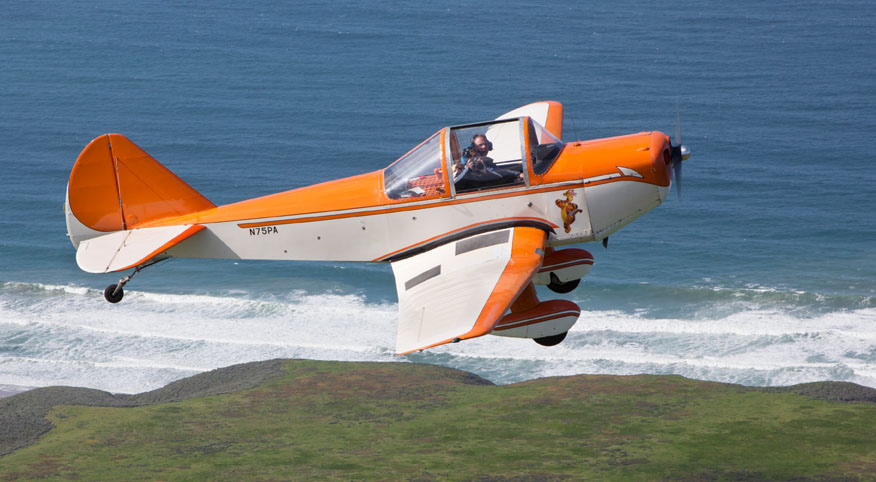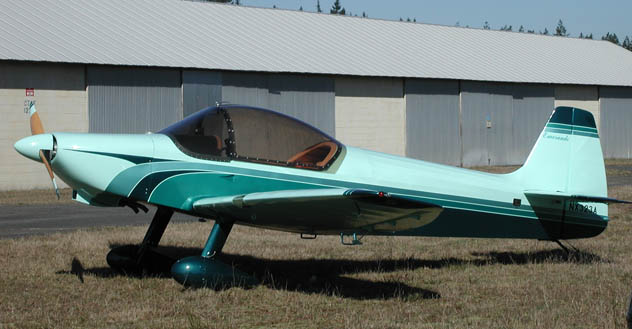The Fly Baby is famous and successful. Namu....not so much. Pete wrote literally dozens of articles about the Fly Baby. I have yet to discover a single article by Pete about Namu. He included it as the cover photo for the 9th edition of his "Guide to Homebuilts," but otherwise documentation is rare.
Sources are few. I found two articles in EAA Sport Aviation (neither written by Pete himself). Joining the Seattle EAA chapter in the '80s, I got a few stories about Pete and Namu, of which I may or may not be remembering them properly. Some information comes from Mike Madrid, the current owner of Namu. I've also had an email conversation with the current owner of one of the OTHER Namus built.

The Design
What was the impetus for the design of Namu? Pete had designed the single-seat Fly Baby in the late '50s, and since then, he'd been pestered about a two-seat version.However, I expect Pete's remarriage might have provided more motivation.
Pete's life has touches of Payton Place. His first wife, married after WWII, was named Alice. They had a son, David.
But in the late '60s, Pete demanded an annulment (he was Catholic, and this was in the time when Catholics couldn't divorce). A few years later, Pete remarried ANOTHER woman named Alice. #2 sounds like a complete b*tch. Pete designed Namu so they could fly together (hence the "N75PA" registration...1975 Pete and Alice). I was told that Alice cut way back on the amount of flying Pete was allowed to do. In fact, other guys in our EAA chapter told me he was only allowed to fly to Arlington every year.
I was also told that Pete's instruction from his new wife was to make the plane wide enough that the occupants weren't touching in flight.
So, Pete had a lot of things he wanted in his new design. The cockpit had to be roomy. It had to fly on a Lycoming O-290G GPU engine Pete already had. With the heavier aircraft, he wanted oleo struts on the landing gear. He wanted a cantilever wing (no external bracing). He didn't need foldable wings, but he did want to be able to remove the wing panels and still be able to roll the fuselage on its own wheels.
Why?
Well, I think the oleo struts for the gear were the main drivers. I suspect they were stock units, used in some production design, and the oleos were too short if the wing were straight. Short field performance was one of his design criteria, and I think he wanted the aircraft to be near the stall angle of attack when in three-point attitude. It allows slower landings.
He certainly didn't need it for prop clearance. The hub of the Lycoming is SIX FEET above the ground.
Where'd the Name Come From?
We don't know what Pete originally was going to call the airplane. The FAA registry for N75PA merely refers to it as the Bowers Model 4, no mention of "Namu."But where did "Namu II" come from?
Pete was actually building two aircraft in the garage of his house. His local EAA friends were quite used to Fly Baby fuselages being worked on in the garage...but these new airplanes were huge in comparison. "Look like whales," one visitor mused.
About five years before Pete started designing the Model 4, a 22-foot-long Killer Whale was captured, and put on display at the Seattle Aquarium. They named it, "Namu."
See where this is going?
The February 1972 issue of SPORT AVIATION had an article about Pete's project, written by editor Jack Cox:
Two "Namu II's" are presently well along in Pete's workshop. Fuselages and tail sections are complete for both and work is beginning on the wings.Pete completed the airplane in 1975, hence the prototype's N-Number: N75PA, with the "PA" standing for Pete and Alice (his wife). It was the Model 4, in Pete's reckoning, and that's what the FAA records still show.
It was here that the name "Namu II" came into being. A friend, used to seeing only narrow "Fly Baby" fuselages in Pete's shop, was impressed by the width of the new bird — "a regular whale by comparison"! This comment started the wheels turning in several heads and finally Walt Disney's TV film about a whale trapped in a Washington cove — a whale named "Namu" — was recalled . .. thus, "Namu II".
First Flight
First flight of Namu #1 happened on July 2nd,
1975. Pete wanted to bring it to Oshkosh that
year, and of course, the big show was less than a month
away. He needed to fly off the required 40 hours
before making the trip.
According to an article by Jack Cox in the October 1975
edition of SPORT AVIATION, Pete lined up 18 friends to
fly the plane constantly until it had passed the 40 hour
point. Pete then flew it to Oshkosh and back, with
no apparent problems.
Cox also had the chance to fly the airplane:
I had an opportunity to make a short flight in Namu II just before the Warbirds' flight period one day at Oshkosh and found the plane to fly very well — excellent ground handling and very docile inflight manners. Performance is quite good for the power — a converted Lycoming GPU Pete has been hoarding for years.
I never flew in Namu, though did get Pete's permission to go inside for a test fit. The interior was all wood, and beautiful. However, I didn't find the plane all that roomy. It had plenty of legroom for me (I'm two inches shorter than Pete), but the cabin just didn't seem that wide. I'm guessing it was about 36 to 38 inches, about the same as a Cessna 150.
Production (?)
As the February 1972 article states, a second Namu was
built at the same time as N75PA. I was told that it was
painted like a Killer Whale, but I've never seen any
photos or other confirmation.
Similarly, I was told that only four sets of plans ever
existed. But several months back, I talked the the
only other known Namu owner. Her plane is
basically derelict; in storage, and its firewall forward
was stolen.
She doesn't believe the "four sets of plans" rumor.
"Far as I know, there were none, other than any final ones actually drawn up by Pete himself. The Namu I have was supposedly built using notes written or sketched on an envelope discarded in a Boeing wastebasket."
Her plane was built by Tom Godby and Dick Lowe, who,
she says, were NOT the ones who recovered the drawings
from the trash. She thinks there may have been as
many of ten Boeing employees or friends involved in the
construction of her airplane.
Amusing story: The FAA application for the plane
originally listed it as a Godby-Lowe-Bowers Namu.
It was changed to "Lowe-Godby-Bowers." Look at the
original name and say it slowly...no doubt Pete would
have agreed.

So we HAVE no confirmation of four airplanes...only photographic evidence of two. There are no known sets of plans out there, and, if my old friend is right, there *won't* be any.
I have one last-ditch place to research, but unfortunately, it's closed due to the pandemic. When things clear up a bit, I'll take one last stab.
Assessment
There's an old saying: "Success has many fathers, but
failure is an orphan." Namu didn't take off like the Fly
Baby. Pete didn't write about it, and, apparently,
didn't sell plans.
Why?
My guess was competition, both the lack of it, and too much
of it.
The Fly Baby itself was born in competition, the 1962 EAA
design contest. This came with a ton of built-in
publicity, and a large batch of eager prospective builders.
Ten years later? Well, not only was there NOT any
design competition to build interest, Namu already had a lot
of competitors out there. Plenty of two-seat homebuilt
designs... the Emeraude, the Skyfly, the Stits Playmate, the
Thorp T-18. Lotsa competition out there, and we should
be frank about Namu's competitiveness: Its performance
wasn't that great, and it wasn't that attractive of an
airplane. Much of it was pleasing, but Pete's
treatment of the engine and cowling wasn't as smooth and
sleek as the drawing above. He used a Super Cub nose
bowl and a flat-wrapped cowling. It's very...abrupt,
and not too attractive.
Jason McDowell Photograph

But Namu's size really got it in the shorts, when it came down to performance. Pete claimed a 120 cruise speed on an O-290G...about the same as an Emeraude with a C-90.... and the C-90 has 30 fewer horsepower!
Let's compare Namu with another contemporary, the Thorp T-18. The T-18 has a wingspan a dozen feet shorter. T-18s with O-360 engines see cruise speed approaching 200 MPH. The only way a Namu was going to approach 200 MPH was in the cargo bay of a C-130.
What's more, consider the era when Namu came out. There were a lot of fast, exciting, easy-to-build homebuilts hitting the market. Dick VanGrunsven was promising a two-seat version of his RV-3. Burt Rutan's first Varieze two months prior to N75PA's completion... and it was at Oshkosh '75, too. Which planes do you think garnered the most attention?
 Return to the Stories Page
Return to the Stories Page